Free E-Mail
Bible Studies
Beginning the Journey (for new Christians). en Español
Old Testament
Abraham
Jacob
Moses
Joshua
Gideon
David, Life of
Elijah
Psalms
Solomon
Songs of Ascent (Ps 120-135)
Isaiah
Advent/Messianic Scriptures
Daniel
Rebuild & Renew: Post-Exilic Books
Gospels
Christmas Incarnation
(Mt, Lk)
Sermon on the Mount
(Mt 5-7)
Mark
Luke's
Gospel
John's Gospel
7 Last Words of Christ
Parables
Jesus and the Kingdom
Resurrection
Apostle Peter
Acts
The Early Church
(Acts 1-12)
Apostle Paul
(Acts 12-28)
Paul's Epistles
Christ Powered Life (Rom 5-8)
1 Corinthians
2 Corinthians
Galatians
Ephesians
Vision for Church
(Eph)
Philippians
Colossians,
Philemon
1
& 2 Thessalonians
1 & 2 Timothy,
Titus
General Epistles
Hebrews
James
1 Peter
2 Peter, Jude
1, 2, and 3 John
Revelation
Revelation
Conquering Lamb of Revelation
Topical
Glorious Kingdom, The
Grace
Great Prayers
Holy Spirit, Disciple's Guide
Humility
Lamb of God
Listening for God's Voice
Lord's Supper
Names of God
Names of Jesus
Christian Art
About Us
Podcasts
Contact Us
Dr. Wilson's Books
Donations
Watercolors
Sitemap
 'The Calling of Saints Peter and Andrew' (6th century), mosaic floor, Church of Sant'Apollinare Nuovo, Ravenna, Italy. |
Many of you are probably quite familiar with the stories of Peter's exploits, his bravado and his impulsiveness. You know that Peter was a fisherman and that he denied Jesus three times. In this study, however, we want to go beyond the basics to see Peter as a whole man, from beginning to end, with particular emphasis on how he grew as a disciple. In this lesson I'll tell you how his journey with Jesus started.
In a moment, we'll look at Peter's first meeting with Jesus, but first I want to tell you how his story ends in Rome about 64 AD. (Incidentally, our best guesses at dating events in Peter's life are found in Appendix 3. Chronology of St. Peter's Life.)
Lactantius (250-325 AD) wrote:
"While Nero reigned, the Apostle Peter came to Rome, and, through the power of God committed unto him, worked certain miracles, and, by turning many to the true religion, built up a faithful and steadfast temple unto the Lord. When Nero heard of those things ... [he] sprang forward to raze the heavenly temple and destroy the true faith. It was he who first persecuted the servants of God; he crucified Peter, and slew Paul."2
By the end of his life, Peter is a powerful healing evangelist, a true fisher of men, and an effective tool in God's hands.
But Peter doesn't begin as an effective tool. Rather, he begins as a brash man who has a tendency to put his foot in his mouth. But then the Spirit comes upon him, Jesus transforms him, and the rest is history. Herein lies Peter's tale.
1.1. Peter Meets Jesus in Judea (John 1:42)
Neither Jesus nor Peter is from Judea; they are Galileans. But they first meet in Judea, along the banks of the Jordan River where John the Baptist is holding a powerful revival, preaching and calling people to repentance.
"Repent, for the kingdom of heaven is near." (Matthew 3:2)
"Prepare the way for the Lord,
make straight paths for him."
(Mark 1:3, quoting Isaiah 40:3)
John the Baptist
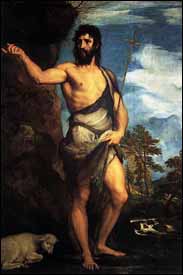 Titian, 'John the Baptist' (1540), oil on canvas, 79 x 52 in, Gallerie dell'Accademia, Venice. Larger image. |
John the Baptist is the Jewish phenomenon of his day. Thousands come from all over Judea to the River Jordan to repent and be baptized for the forgiveness of their sins. Even as far away as Galilee, hopeful Jews take the four-day trek south to where John is preaching and baptizing in the wilderness places along the Jordan River.
John's ministry has such an impact on the Judaism of the time that the effects of his ministry show up decades later in the Jewish Diaspora where Paul ministers.3 As late as 94 AD, Jewish historian Josephus mentions John's revival in his Antiquities of the Jews.4
Behold, the Lamb of God (John 1:29)
Where we pick up the story, John has baptized Jesus of Nazareth. Shortly after this, he points to Jesus and says:
"Look, the Lamb of God, who takes away the sin of the world!" (John 1:29)
A lamb is a common sacrifice offered in the temple to atone for sin. "Lamb of God" means lamb sent by God. A lamb who "takes away the sin of the world" is a mighty sacrifice indeed. Most lambs sacrificed in Jerusalem might atone for the sins of a person or perhaps a family on Passover. But a sacrifice that atones for the sins of the whole world? That is astounding! We'll come back to it briefly in https://www.jesuswalk.com/peter/11_death.htm#11-7-View.
Andrew and His Brother Simon Peter
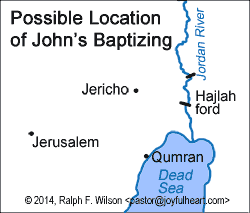 Possible location of John's baptizing. Larger image. |
John utters the saying a second time. This time, Andrew, Peter's brother, hears it.
""35 The next day John was there again with two of his disciples. 36 When he saw Jesus passing by, he said, 'Look, the Lamb of God!'
37 When the two disciples heard him say this, they followed Jesus. 38 Turning around, Jesus saw them following and asked, 'What do you want?'
They said, 'Rabbi' (which means Teacher), 'where are you staying?'
39 'Come,' he replied, 'and you will see.'" (John 1:35-39).
The two former "disciples" of John the Baptist immediately begin to follow after this man whom John has called the "Lamb of God." These disciples have switched allegiance.
When Jesus asks them what they want, they mumble something about where he is staying while in Judea. I love Jesus' response.
"Come and you will see."
He doesn't give them a location, but an invitation to join him in walking there, the beginning of their JesusWalk. They spend the rest of that day with Jesus.
"40 Andrew, Simon Peter's brother, was one of the two who heard what John had said and who had followed Jesus. 41 The first thing Andrew did was to find his brother Simon and tell him, 'We have found the Messiah' (that is, the Christ). 42 And he brought him to Jesus." (John 1:40-42a)
Jesus convinces Andrew. He, in turn, finds his brother among the crowds, tells him that Jesus is the long-awaited Messiah, and brings Peter with him to where Jesus is.
You Will Be Called Cephas (John 1:42b)
After Andrew's brief introduction, Jesus looks directly and intently5 at Peter and immediately gives a prophecy. I am sure that Andrew introduced his brother to Jesus as "Simon," but Jesus doesn't stop by repeating his name -- "Oh, Simon, son of John, it is good to meet you." He says,
"'You are Simon son of John. You will be called Cephas' (which, when translated, is Peter)." (John 1:42)
When I picture this scene, I see a bit of a smile forming at the corners of Jesus' mouth. With this new name are hints of something to come, but Jesus doesn't explain what he means. All the more intriguing to Peter, who becomes aware that this new rabbi knows something about him and his future that he doesn't know.
Peter's Names
Let's pause here and go over Peter's names that are used in the New Testament.
- Simon is an extremely popular name among Jews because it is the name of Jacob's second son, Simon. The name from sh imʿôn, "hearing."6
- Son of John or Jonas is Peter's patronymic or father's name. This would distinguish him from some other Simons. In English, we often have fathers' names built into our surnames: Wilson (Will's son), Hanson (Han's son), Johnson (John's son), etc.7
- Cephas is the Aramaic word for "rock."8
- Peter, from petros, is the Greek word for "rock, stone." Why does Jesus call him Cephas/Peter/Rock? Because of a rock's firmness and strength as a foundation as we'll see in Matthew 16:17-19 (Lesson 3.2.2).
1.2. Set Free by the Blood of the Lamb (1 Peter 1:18-19))
Before we continue with the narrative, I want to go back to John's words, "Behold, the Lamb of God who takes away the sin of the world" (John 1:29), that attracted Andrew to Jesus.
Fast-forward to perhaps 60 AD. Peter is now an old man. He is in Rome preaching, establishing the saints there. The letter he writes to some churches where he had ministered is known as First Peter.
"18 You know that it was not with perishable things such as silver or gold that you were redeemed from the empty way of life handed down to you from your forefathers, 19 but with the precious blood of Christ, a lamb without blemish or defect." (1 Peter 1:18-19)
 Peter says much more in the letter, of course. For a full exposition, see my study, 1 and 2 Peter with Jude: Discipleship Lessons from the Fisherman (JesusWalk, 2023). |
The Lamb of God, whom Peter meets along the Jordan River, has given his life on the cross for the sins of the world like a sacrifice to make atonement.
Peter points to the blood of this sacrifice, " "the precious blood of Christ, a lamb without blemish or defect." The mention of blemish and defect is to suggest that Christ is a sacrifice that meets the legal requirements for sacrifice for sin -- perfect: no blemish, no defect.
Why is the Lamb's blood so "precious" or valuable? Because this Lamb is the Messiah, the God-anointed Savior, who is the Son of God himself! He is the Lamb of God who takes away the sin of the world. As Peter says in his First Letter:
"Christ died for sins once for all, the righteous for the unrighteous, to bring you to God." (1 Peter 3:18)
Peter had been utterly changed by Jesus and by Jesus' payment for his sins. Through Christ's sacrifice on the cross, your sins can be forgiven too, and your life changed. Hallelujah!
One important part of this series of lessons are four or
five Discussion Questions in each lesson. We learn by reflecting on what we
have studied, processing it, and thinking through its implications. If we don't
process, we don't learn well or grow spiritually. Don't skip this step, or you
will have gained head knowledge without heart knowledge! I encourage you to
write out your own answer to each question, perhaps in a journal. If you are
studying with others, discuss it.
Q1. (1 Peter 1:18-19) Why is Christ's blood so expensive? What does allowing
his blood to be shed for you say about your worth? About God's love for you?
1.3. Fishers of Men (Mark 1:16-20)
John's Gospel tells the story of Jesus meeting Peter in Judea along the Jordan River. The Synoptic Gospels (Matthew, Mark, and Luke) tell the story of Peter's calling along the shores of Galilee.
After Jesus' baptism in Judea, he spends 40 days fasting in the desert areas of Judea, being tempted by the devil. After this, he returns to his home region of Galilee. He doesn't return to live in Nazareth, but centers his early ministry in Capernaum, a fishing village on the north shore of the Sea of Galilee (Matthew 4:12-13).
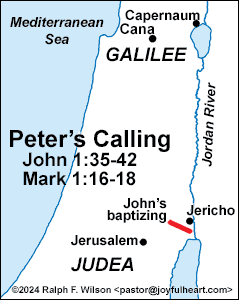 Galilee and Judea. Larger map |
Up to now, Peter has been growing in his allegiance to Jesus, but following Jesus has not yet become an irrevocable life decision for him. This is about to change.
We have two different accounts of the call of Peter in the Synoptic Gospels.
- Fishers of Men (Mark 1:16-18 = Matthew 4:18-20). Matthew and Mark give the final response to Peter's calling on the beach at Capernaum.
- Miraculous Catch of Fish (Luke 5:1-11). Luke gives the miraculous catch of fish as the reason for Peter's submission to Jesus.
I am inclined to see Luke's account as an expansion of the same event we see in Mark and Matthew, but we'll look at each account separately.
Incidentally, the Synoptic Gospels have a lot in common, probably due to a common body of traditions about Jesus' ministry. But on a number of points they vary. We'll refer to these variations occasionally. For more on this, see Appendix 4. The Synoptic Problem.
Nets and Fishing Boats
 Towns of Galilee. Larger map. |
Both stories feature fishing nets, which play a big part in the business of commercial fishing on the Sea of Galilee. There are four primary ways to catch fish in ancient days:
- A line and hook (see Lesson 2.4).4)
- Spearing.9
- Casting net, and
- Seine or dragnet.
The nets interest us here.
Casting net. Poorer fishermen who didn't own boats could use casting nets along the shore. The casting net is thrown out over the water. Weights at the edge pull the net to the bottom, trapping any fish that might be under it. The net opening may be 10 to 20 feet (3 to 6 meters) in diameter. The fisherman wades out to the net, gathers it in, and brings any fish to shore.10
Seine net or drag net. The seine or drag net is substantially larger. In Jesus' day, these were large vertical wall-like nets, with floats along the top, with the ends attached either to the shore or to another boat. A boat might drag one end of the net out into the water in a semicircular arc and then back to the shore again, pulling in the fish as it returns. Now a team of fishermen on both ends of the net heave it into shore. One might dive in the center to disentangle it from any rocks or obstructions on the bottom as the net drags across.11
Another way to use this kind of net is to take it into deep water, often at night and sometimes with another boat, laying out the floats at the top of the net in a long line across the water. Fish might be driven into the net by the splashes of the fisherman. Then the ends are pulled together surrounding a school of fish, and pulled on board the boat.12
The fishermen would sell their fish fresh in the local markets. The rest they would salt and dry for export as far as Spain.13 As owners of their own ships who sometimes hired others to help, Peter and his partners would be regarded as members of the lower middle class, rather than a very low social class.14
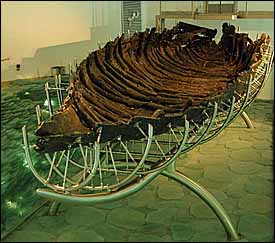 The 'Jesus Boat' on a metal frame at Kibbutz Ginosar near ancient Gennesaret on the northwest shore of the Sea of Galilee. Photo: Travellers & Tinkers, Creative Commons Attribution-Share Alike 4.0 International license. Larger image. |
In the drought year of 1986, a partly-submerged boat was found on the northwest shore of Galilee, and now preserved nearby at the Yigal Allon Galilee Boat Museum in Kibbutz Ginosar. The boat is 27 feet (8.2 m.) long, 7.5 feet (2.3 m.) at its widest point, and with a maximum preserved height at the gunnels of 4.3 feet (1.3 m.). The boat dates from between about 50 BC to about 50 AD and is made primarily of cedar planks joined by pegged mortise and tenon joints and nails. It is shallow drafted with a flat bottom, and would be row-able with four staggered rowers. There is also a mast allowing the men to sail the boat.15 Peter's boat may well have been similar.
A boat of cedar planks in a land with few trees to fell would have been expensive. The cedar would probably have been imported from Lebanon. A boat like this would indicate a significant asset to Peter's business.
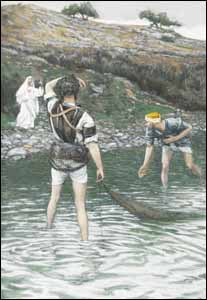 |James J. Tissot, 'The Calling of St. Peter and St. Andrew (1896-1903), gouache on wove paper, The Brooklyn Museum, New York. Larger image. |
Fishers of Men (Mark 1:16-18 = Matthew 4:18-20)
Luke's account of Peter's call centers on the miracle of the miraculous catch of fish. Matthew's and Mark's accounts focus immediately on Peter's call. Here is Mark's account.
"n>"16 As Jesus walked beside the Sea of Galilee, he saw Simon and his brother Andrew casting a net into the lake, for they were fishermen. 17 'Come, follow me,' Jesus said, 'and I will make you fishers of men.' 18 At once they left their nets and followed him.
19 When he had gone a little farther, he saw James son of Zebedee and his brother John in a boat, preparing their nets. 20 Without delay he called them, and they left their father Zebedee in the boat with the hired men and followed him." (Mark 1:16--20)
Peter's partners seem to be tending their dragnets after a night's fishing (Mark 1:19), while Peter and Andrew are using a casting net16†in the shallows, hoping to catch at least a few fish for the night's work. The brothers are working as a team, throwing out a casting net, then drawing it in to see if they had trapped any fish.
Jesus is walking along the rocky beach. He calls to them.
"17 'Come, follow me,' Jesus said, 'and I will make you fishers of men.' 18 At once they left their nets and followed him." (Mark 1:17-18 = Matthew 4:19-20)
When Jesus says, "Come, follow me" in verse 17, he means following someone as an adherent, the way a disciple would follow a rabbi.17 This is reinforced in verse 18 by the verb akoloutheō, "to follow someone as a disciple, be a disciple, follow." This verb is used at the call of Matthew/Levi,18 as well as elsewhere in the context of discipleship.19 It means becoming devoted to being present with a rabbi and learning from him wherever he goes.
Notice the fishermens' response. There's no more thinking it over. They have heard the Master. He has called them personally. They are ready! Immediately, they forsake their nets and way of life and begin to follow Jesus as his disciples. There is a time to make a decision. For Peter and Andrew, that time is now.
1.4. Leaving Everything (Matthew 19:27-30)
There is both the negative and the positive, the leaving and the following. Leaving his life of fishing is a big step for Peter and his family. Later, when the rich young ruler is asked to sell all his possessions and follow Jesus -- and declines to do so, Peter is troubled.
"Peter answered him, 'We have left everything to follow you! What then will there be for us?'" (Matthew 19:27)
We have done what the rich young ruler refused to do, Peter is saying, though we were not nearly as wealthy. What comes to those who obey Jesus' command to leave everything and follow? Jesus assures him of rewards, both on earth and in the Kingdom to follow. Is God calling you to leave something behind so you can follow Him more closely?
When Jesus takes something away in our lives, he usually replaces it with something else important. Sometimes the taking away involves loved ones and great pain. But in the healing process, look for what Christ brings to encourage you. Our ultimate reward, of course, is in heaven. Jesus' answer to Peter's question is glorious, even though some of the glory will be delayed.
"28 I tell you the truth, at the renewal of all things, when the Son of Man sits on his glorious throne, you who have followed me will also sit on twelve thrones, judging the twelve tribes of Israel. 29 And everyone who has left houses or brothers or sisters or father or mother or children or fields for my sake will receive a hundred times as much and will inherit eternal life.30 But many who are first will be last, and many who are last will be first." (Matthew 19:28--30)
Q2. (Mark 1:16-18; Matthew 19:27-30). Why do we sometimes put off following through with things we know God is calling us to do? Is it fear? Is it an unwillingness to pay the cost of that decision? Is there something you feel God calling you to do? What does it tell us about Peter and Andrew that they "immediately left their nets and followed"?
 Raphael, detail, 'The Miraculous Catch of Fishes' (1515), cartoon for tapestry, full image 11.8x13.1 ft., royal collection, Victoria and Albert Museum, London. Full image |
1.5. The Miraculous Catch of Fish (Luke 5:3-8)
Matthew and Mark's account of Peter's calling is simple. Jesus calls, Peter and Andrew follow. Luke's account is more complex. I think each of the Synoptic passages recount the same incident, but Luke's account includes a few more details, especially the miraculous catch of fish that seems to immediately precede Peter's calling in Matthew and Mark.
Teaching from the Boat (Luke 5:1-3):1-3)
Luke's account begins with Jesus' teaching that morning along the shore.
"11 One day as Jesus was standing by the Lake of Gennesaret, with the people crowding around him and listening to the word of God, 2 he saw at the water's edge two boats, left there by the fishermen, who were washing their nets. 3 He got into one of the boats, the one belonging to Simon, and asked him to put out a little from shore. Then he sat down and taught the people from the boat." (Luke 5:1-3)
The other fishermen have been "washing20 their nets," probably washing off the fish slime and other debris from the lake bottom they had collected from a night of fishing. Nets would also need to be mended where thrashing fish or disentangling the fish from the net have broken the cords. Finally, they are dried and folded for the next night's work.21
Jesus is teaching on the shore of the Sea of Galilee (called here, the Lake of Gennesaret after the fertile coastal plain known as Gennesaret that extends along the northwest shore of the lake). People are crowding around Jesus, making it difficult for others to see and hear him. So, to get some more space, Jesus asks Peter if he can teach from his fishing boat floating near the shore.22]22 The request is deliberate; Jesus has something very special to show Peter. I imagine, too, that Peter glows with pride that his boat has been selected by the Teacher, and that he can sit next to him, publicly sharing a bit of the glory.
Putting Out into Deeper Water (Luke 5:4-5)
The boat bobs gently on the surface of the lake as Jesus expounds his message to the crowd. Then, after he has finished teaching the people, Jesus turns to Simon with a strange request.
"4 When he had finished speaking, he said to Simon, 'Put out into deep water, and let down the nets for a catch.'
5 Simon answered, 'Master, we've worked hard all night and haven't caught anything. But because you say so, I will let down the nets.'" (Luke 5:4-5)
Fishermen in boats usually worked at night (also John 21:3b), since the fish are generally more active at night -- and perhaps to avoid monitoring by tax collectors who would tax a catch. Some have suggested that they used a torch to attract the fish to the surface, but we have no records of that technique in this period.
Mornings would be given to mending the nets, sorting fish, and perhaps using casting nets along the shore if their night's labor hadn't "netted" any fish (Matthew 4:18; Mark 1:16).
Peter is frustrated, since the previous night they hadn't caught much of anything. And what does this landlubber know about fishing? But because he respects Jesus, Simon responds to Jesus' request.
A Massive Haul of Fish (Luke 5:6-7)
The net to be "let down" here is the larger vertical dragnet or seine net.
"6 When they had done so, they caught such a large number of fish that their nets began to break. 7 So they signaled their partners in the other boat to come and help them, and they came and filled both boats so full that they began to sink." (Luke 5:6-7)
A whole school of fish suddenly hits the net and pulls hard against the boat threatening to tip it over. Peter is instantly alert and begins to give orders pulling in the ropes on the net to bring it closer to the boat. It is a huge catch. He steadies himself by the mast and shouts at the top of his lungs across the water where his partners James and John are still mending nets.
"H-E-L-P U-S," he shouts into the wind. "C-O-M-E A-N-D H-E-L-P U-S!"
Far away on the shore he can see that they've heard him and are running for their boat. Now he turns back to the task at hand and doesn't look up until James' and John's boat is alongside, helping to pull fish out of the net into their boat, flapping, flopping on the boat bottom. I imagine that Jesus, too, is pulling fish aboard as fast as he can. The men work noiselessly until the last of the huge catch is into the boats, the gunnels now dangerously close to the waterline.
Carefully, oh, so carefully, they row the laden boats ashore, not relaxing until they can hear the prow crunch on the rocks of the beach. It is the biggest catch they have ever brought in. And not at night, but in the daytime!
Catching Men (Luke 5:10b)
In the presence of such awesome power, Peter is suddenly terrified.
"When Simon Peter saw this, he fell at Jesus' knees and said, 'Go away from me, Lord; I am a sinful man!'" (Luke 5:8)
It reminds me of Isaiah's vision of God Almighty on his throne, when Isaiah cries out.
"Woe to me! ... I am ruined! For I am a man of unclean lips, and I live among a people of unclean lips, and my eyes have seen the King, the Lord Almighty." (Isaiah 6:5).
Convicted by the power of God, Peter falls on his knees in awe and shame, acutely aware of his own sinfulness. "Depart from me, Lord! I am a sinful man."
We learn here that God isn't afraid to call sinful men and women to be his high servants. To mix metaphors, some preacher once said, "God catches his fish before he cleans them." God is able to work on us so that he can use us -- in spite of our imperfections.
Jesus, who has prepared Peter and the other fishermen by means of this miracle, now rejects Peter's plea to distance himself.
"Then Jesus said to Simon, 'Don't be afraid; from now on you23 will catch men.'" (Luke 5:10b)
Notice in this recounting, there is no explicit "call" or command of "Follow me" that we see in the Mark and Matthew versions. Rather, it is a prediction of future events.
"From now on you will catch men." (Luke 5:10b)
The time frame is "From now on," from this time forward.24 The action is, "You will catch men." "Men" (anthropos) in verse 10 doesn't refer to males in particular, but to humans in general.
The verb used here is nearly unique in the New Testament: zōgreō, "to capture alive" or "to spare life," and it builds on the idea of the miraculous "catch." The word is used in the Septuagint and in Greek literature in the vocabulary of war and hunting. Peter had been catching fish to kill and sell them. But now he will be taking men alive to give them liberty.25 The only other time the word is used in the New Testament is in 2 Timothy 2: 26, where opponents have been enslaved by the devil, "who has taken them captive (zōgreō) to do his will." Men can either be live captives of Satan, or freed servants of Jesus. Jesus "captures" men to set them free.
Leaving Everything and Following (Luke 5:11)
"So they pulled their boats up on shore, left26 everything and followed him." (Luke 5:11)
Discipleship requires a leaving, a turning away from, as we saw above. It also requires a following. The word "followed" here is akolutheō that we saw in Matthew's and Mark's accounts, "to follow someone as a disciple." It comes from the word for "road" -- "walking the same road." It follows in the tradition of the rabbinical master-pupil relationship. [27]
Q3. (Luke 5:3-11) Why does Peter hesitate to put out into the "deeper waters" after fishing all night? Why do we hesitate? What is the reward of deeper waters vs. the shallows? How much does deep repentance depend upon how a person can see his sin in relation to God's holiness? Who gives this revelation? Can Peter experience true repentance from his sin if he does not leave everything and follow? What is the relationship of obedience to repentance?
1.6. Healing of Peter's Mother-in-Law (Mark 1:29-30)
 Jesus heals Peter's mother-in-law. Artist unknown. |
After his baptism in Judea, Jesus has been ministering in Galilee.28 We hear of ministry in Cana (John 2), Capernaum (Luke 4:23), and Nazareth (Luke 4:16-30), among other towns. But now Jesus seems to select a base of operations in Capernaum, from which he preaches throughout the whole region.
"Leaving Nazareth, he went and lived in Capernaum." (Matthew 4:13a)
He stays at the house of Simon Peter.
Jesus preaches in the synagogue in Capernaum and casts out an unclean spirit from a man there in a rather spectacular exorcism that sends stories of his power blazing through the area. From the synagogue, he goes to Peter's house, where we learn more about Peter.
Each of the Synoptic Gospels includes the account of the healing of Peter's mother-in-law relatively early in Jesus' ministry.29
"29 As soon as they left the synagogue, they went with James and John to the home of Simon and Andrew. 30 Simon's mother-in-law was in bed with a fever, and they told Jesus about her. 31 So he went to her, took her hand and helped her up. The fever left her and she began to wait on them." (Mark 1:29-31)
Peter's Family
Peter, Andrew, and Philip are originally from "Bethsaida of Galilee" (John 1:44; 12:21), a fishing village a few miles east of Capernaum. "Beth-saida" means "house of fishing." However, they have now moved to Capernaum.
Peter is married. If you've watched The Chosen series on the life of Jesus (2017- ), there is a whole back-story of marital tension between Peter and his wife, called Eden in the series. Director Dallas Jenkins does excellent character development. I love it, but realize that most of the backstory about the interplay between characters in The Chosen is fiction -- believable fiction used to tell the story of Jesus quite effectively -- but fiction nevertheless. Be careful as you are studying Peter's life not to let The Chosen's fictional account of Peter affect what you are learning directly from Scripture.
Scripture doesn't tell us any more about Peter's wife, except that later, she and Peter travel together in ministry.30 Later church tradition tells us that her name is Gogia, with sons Joel and Yovana, and daughter Sabistha. Church tradition indicates that his wife is martyred shortly before Peter.31
As is common in this culture, Peter and his wife are living with extended family -- his mother-in-law and his brother Andrew, who is probably unmarried at this point. Peter's business is prosperous enough that he can build or purchase a stone house in this fishing town.
If you go to Capernaum today, you can see the ruins of what purports to be Peter's house. It seems to have been converted from a house to a worship center by about the middle of the first century AD.32
Healing Peter's Mother-in-Law
Peter, now committed to follow Jesus as a disciple, brings his new Master home to dine and stay with him in his house. But when Jesus enters the home, it becomes clear that Peter's household is in crisis. Peter's mother-in-law is lying sick of a fever,33 Luke says, "a high fever" (Luke 4:38). She is burning up, severely sick, and since she is an older woman, her family are afraid she is dying. They quickly explain34 her situation to Jesus and appeal35 to him to heal her.
This reminds me of the fact that when we invite Jesus into our lives, we also expose him -- and feel we have to explain to him -- all the messes and difficult situations of our lives, at least the ones we are aware of. And he cares. We ask him and he begins to heal us and help us get our house in order. Salvation's touch often begins with the close, intimate things.
Jesus's healing comes through a touch and a word. Each of the Gospel writers explains the moment in his own words.
"He touched her hand and the fever left her." (Matthew 8:15)
"He went to her, took her hand and helped her up. The fever left her...." (Mark 1:31)
"He bent over her and rebuked the fever, and it left her. She got up at once... ." (Luke 4:39)
Each of these has the marks of an eyewitness account of this tender moment, each seeing different aspects of the moment.
As soon Peter's mother-in-law is on her feet, she goes about serving Jesus and the rest of the family as is her practice. The healing and recovery are instantaneous. Peter's mother-in-law is known for serving.
Q4. (Mark 1:29-31) What does this incident teach us about Peter and his life situation? How does the mother-in-law's healing affect the life situation? How can Jesus' healing affect your life situation?
1.7. Peter Searches for the Missing Master (Mark 1:35-39)
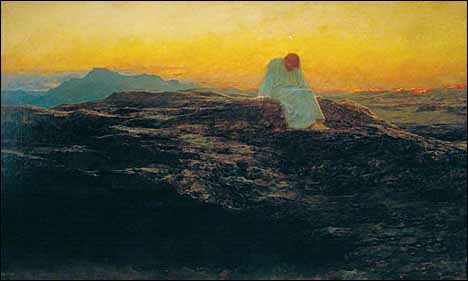 Briton Rivière, 'The Temptation in the Wilderness' (1898), oil on canvas, 46 x 74 in., Guildhall Art Gallery, London. |
Following a meal at Peter's house, the house's doorstep is mobbed by the sick and needy from all over the region. It is the next morning where we pick up the narrative:
"35 Very early in the morning, while it was still dark, Jesus got up, left the house and went off to a solitary place, where he prayed. 36 Simon and his companions went to look for him, 37 and when they found him, they exclaimed: 'Everyone is looking for you!'
38 Jesus replied, 'Let us go somewhere else -- to the nearby villages -- so I can preach there also. That is why I have come.' 39 So he traveled throughout Galilee, preaching in their synagogues and driving out demons." (Mark 1:35-39)36
After an incredible evening of healing and exorcism, Jesus stays the night at Peter's home. Overnight Jesus moves from itinerant preacher to rock-star-like fame, at least in Galilee. His ability to heal and cast out demons has inspired all of Galilee to rush to Capernaum with all their sick and troubled kinfolk.
First thing in the morning, people are at the door looking for Jesus. My father needs healing. My child needs deliverance. Peter, I must see Jesus. Where is he?
So Peter organizes a search party to find his newly-famous friend. Capernaum is built next to a sloping rocky beach at the north end of the Sea of Galilee. Above the town are low hills with canyons sloping down to intermittent creeks (wadis) to the east and west. The beach with its fishing boats wouldn't offer much quiet, so I'm guessing Jesus hikes up the hill above the homes below and finds a spot where he can talk to his Father undisturbed and watch the morning sun rise over the lake.
The search party finally finds Jesus in a "solitary place" praying. The searchers say to Jesus, probably Peter himself, since he seems to be the organizer:
"Everyone is looking for you!" (Mark 1:36b)
This statement packs a lot of meaning. It implies that,
- Jesus should do what people want him to do.
- Jesus is wrong for disappearing when he is needed.
- People like Peter should attempt to influence what Jesus does.
They sound like Hollywood agents trying to acquaint a new actor with his responsibilities to his public, to his fans. No doubt, they go on to explain that Jesus is needed, that he should continue to heal the new crowds of sick people in town who are demanding his help.
 Available in book versions: paperback, PDF, and Kindle |
This may be the first time Peter tries to "manage" Jesus, but not the last. Later he tells him that he shouldn't go to the cross, and receives a strong rebuke (Lesson 3.1.5).
Jesus' response, no doubt what he has been talking over with his Father in this time of solitude and prayer is about his direction for the day -- completely different than Peter's plan for him.
"38 Jesus replied, 'Let us go somewhere else -- to the nearby villages -- so I can preach there also. That is why I have come.' 39 So he traveled throughout Galilee, preaching in their synagogues and driving out demons. "(Mark 1:38--39)
Q5. (Mark 1:33-39) Why does Jesus get away? What does Jesus praying tell us about him? About our own needs? Why does Peter organize a search party to find Jesus? What does Peter assume Jesus should be doing? How do Peter's plan and Jesus' plan for the day differ from each other?
We've made a good start examining Peter's first days with Jesus -- and learning from what we see. Next, we'll explore Peter as he begins to grow as a disciple.
Prayer
Father, as we get to know you it seems that we, like Peter, bumble around, not really understanding what it means to follow you. Teach us to be followers who are quick to listen. Disciples who are eager to learn, not too wise in our own deceits to be willing to change. Have mercy on us and help us, we pray, in Jesus' name. Amen.
Lessons for Disciples
Here are some of the lessons from these early incidents in Peter's life. You may find others as well.
- Christ's death on the cross is likened to an atoning sacrifice -- the Lamb of God sets us free from sin and an empty lifestyle (John 1:29, 35; 1 Peter 1:18-19). His blood is precious, exceedingly valuable, suggesting how much God values us (§1.1, 1.2).
- Answering Christ's call involves accepting his direction for our lives and leaving our old life behind (Mark 1:17-18; §1.3).
- Though we must leave our old lives in order to gain his, the blessings and benefits in this life and the next from following Jesus are incalculably greater (Matthew 19:27-30; §1.4).
- Jesus sometimes calls us to do things we feel are irrelevant, such as letting down the nets after a night of catching nothing. But obedience can yield remarkable results (Luke 5:3-11; §1.5).
- Sometimes God can bless us with a sudden and extremely uncomfortable realization of our own sin and corruption. Fear can push us away; faith helps us to receive his grace, accept his cleansing, and move into a new relationship with him. Repentance and surrender are keys to growth (Luke 5:3-11; §1.5).
- As we invite Jesus into our complex and messy lives, he will begin to heal and fix some of our embarrassments and things that drag us down. He cares about blessing and reordering our whole lives (Mark 1:29-30; §1.6).
- Jesus sets a pattern of getting away for a time of prayer at the beginning of each day to seek clarity and direction. We disciples are to adopt this pattern (Mark 1:35-39; §1.7).
- Peter learns quickly that he shouldn't try to direct, control, or know better than Jesus. Disciples find that Jesus knows what he is doing; we follow, not direct him (Mark 1:33-39; §1.7).
Key Verses
There are many important verses in this lesson, but these might be worth memorizing.
"Look, the Lamb of God, who takes away the sin of the world!" (John 1:29, NIV)
"'Come, follow me,' Jesus said, 'and I will make you fishers of men.' At once they left their nets and followed him." (Mark 1:17-18, NIV)
"Very early in the morning, while it was still dark, Jesus got up, left the house and went off to a solitary place, where he prayed." (Mark 1:35, NIV)
End Notes
[2] Lactantius, On the Deaths of the Persecutors 2.
[3] Acts 18:25; 19:1-7.
[4] Josephus, Antiquities, 18.5.2 [116-119].
[5] "Looked" (NIV, ESV, NRSV), "beheld" (KJV) is the Aorist participle of emblepō, "to look at something directly and therefore intently, look at, gaze on." (BDAG 321, 1).
[6] Nearly always in the New Testament, Peter's given name Simon is the Greek name simon, but twice it is symeōn (English: Simeon), the Semitic name for which the similar-sounding Greek name simōn is sometimes substituted -- Acts 15:14 and 2 Peter 1:1 (BDAG 967, 5).
[7] In Matthew 16:17 the patronymic is given as bariōna, where Bar- means "son of". In John's Gospel, his father's name is given as John ('Iōannēs, John 1:42; 21:15-17). In Matthew 16:17, it is Jonah, the reluctant prophet eaten by a great fish ('Iōnas).
[8] Cephas, the Aramaic form of the nicknamem is used in Paul's letters (1 Corinthians 1:12; 3:22; 9:5; 15:5; Galatians 1:18; 2:9, 11, 14).
[9] Fish spears or harpoons were used in the Nile as pictured in hieroglyphics and tomb paintings, mentioned in Job 41:7.
[10] The Greek word diktyon is the more general word used for "net for catching fish" (BAGD 198; Carl G. Rasmussen, "Net," ISBE 3:524). When used with Greek amphiblēstron it indicates this "circular casting-net" (Matthew 4:18; Mark 1:16) (BAGD 47). The verb is amphiballō, "cast," a technical term for the throwing out of the circular casting-net (Mark 1:16).
[11] The dragnet or seine net is usually indicated by the Greek word diktyon and once by sagēnē, "a large dragnet," used in Jesus' Parable of the Net (BAGD 739).
[12] Gary M. Burge, "Fishers of Men: The Maritime Headquarters of Jesus' Headquarters in Galilee," Christian History, Summer 1998, p. 36. Burge calls this a "trammel net," though I would guess that the sophisticated kind of net he describes hadn't been developed in the first century.
[13] Great People of the Bible and How They Lived (Reader's Digest Association, 1974), p. 439.
[14] Adrianus van Selms, "Fishing," ISBE 2:309-311.
[15] Wikipedia article, "Sea of Galilee Boat."
[16] "Casting a net" in Mark's account is the verb amphiballō, "cast," a technical term for throwing out of the circular casting net (BDAG 55). "Casting a net" in Matthew's account is the verb ballō, "to throw," plus the noun amphiblēstron, "a circular casting-net used in fishing" (BDAG 55).
[17] "Come, follow me" (NIV), "follow me" (ESV, NRSV), "come ye after me" (KJV) is two words, the adverb deute, "Come here! Come on!" as a hortatory particle (BDAG 220), and the adverb opisō, "a marker of position behind an entity that precedes, 'after,'" functioning as a preposition, "come after someone, follow someone" (at the same time in the transferred sense, "be an adherent/follower") (BDAG 716, 2a).
[18] Matthew 9:9; Mark 2:14; Luke 5:27-28.
[19] Mark 8:34; John 1:37; Matthew 8:19; 19:21.
[20] "Washing" is the imperfect of plunō, "to wash something other than a part of the body [which would use the verb louō], wash" (BDAG 832, 1).
[21] In the other account of calling, James and John are "preparing" (NIV), "mending" (ESV, NRSV, KJV), katartizō, "to cause to be in a condition to function well, put in order, restore," here, "restore to a former condition, put to rights" (BDAG 526, 1a).
[22] Jesus teaches from a boat in another incident a bit later in his ministry (Matthew 13:2 = Mark 4:1).
[23] You (implied) is singular, not plural.
[24] Literally, "from the now," nun, "now, temporal marker with focus on the moment as such" ... "the present time" (BDAG 1aβ Gimmel).
[25] Zōgreō, BAGD 340. Green, Luke, pp. 234-235.
[26] "Left everything" (NIV, ESV, NRSV), "forsook all" (KJV) uses the verb aphiēmi, here, "to move away, with implication of causing a separation, leave, depart from" (BDAG 156, 3a).
[27] Akolutheō, BAGD 31; Thayer 22; Gerhard Kittel, akoloutheo, ktl. TDNT 1:210-216.
[28] Matthew 4:12-17; Mark 1:14; Luke 4:14; John 12:12.
[29] Mark places the healing of Peter's mother-in-law immediately following the call of Peter and Andrew (Parallels §13). In Luke, the time relationship between the call and this healing, isn't specific (Parallels §13). In Matthew, the healing of the centurion's servant in Capernaum (Parallels §46) is followed by the healing of Peter's mother-in-law.
[30] 1 Corinthians 9:5.
[31] Clement of Alexandria (150-215 AD, Stromata, book 7, chapter 11) writes: "They say, accordingly, that the blessed Peter, on seeing his wife led to death, rejoiced on account of her call and conveyance home, and called very encouragingly and comfortingly, addressing her by name, Remember the Lord. Such was the marriage of the blessed and their perfect disposition towards those dearest to them." Clement's account is cited by church historian Eusebius (260-339 AD), History 2, XXX, 1-2. Eusebius claims that "Peter and Philip begat children." There is a late tradition of a daughter, St. Petronilla, mentioned first in Apocryphal Acts of SS. Nereus and Achilles that gives a legendary account of her life and death.
[32] "The House of Peter: The Home of Jesus in Capernaum?" Bible History Daily, 12 Oct 2023 (https://www.biblicalarchaeology.org/daily/biblical-sites-places/biblical-archaeology-sites/the-house-of-peter-the-home-of-jesus-in-capernaum/).
[33] "Fever" is pyretos, "fever" (BDAG 899), from pyr, "fire," from which we get our word "pyre."
[34] In Mark 1:30 "told/tell" is the present active indicative of the very common verb legō, "say, tell."
[35] In Luke 4:38, "asked" (NIV, NRSV), "appealed" (ESV), "besought" (KJV) is the Aorist tense of the verb erōtaō, "to ask for something, ask, request" (BDAG 395, 2).
[36] The account of searching for Jesus is found in Mark 1:35-38 and Luke 4:42-44 only, Parallels §15, though Simon's role is mentioned only in Mark.
Copyright © 2025, Ralph F. Wilson. <pastor![]() joyfulheart.com> All rights reserved. A single copy of this article is free. Do not put this on a website. See legal, copyright, and reprint information.
joyfulheart.com> All rights reserved. A single copy of this article is free. Do not put this on a website. See legal, copyright, and reprint information.
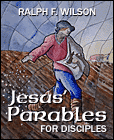
|

|
In-depth Bible study books
You can purchase one of Dr. Wilson's complete Bible studies in PDF, Kindle, or paperback format -- currently 48 books in the JesusWalk Bible Study Series.
Old Testament- Abraham, Faith of
- Jacob, Life of
- Moses the Reluctant Leader
- Joshua
- Gideon
- David, Life of
- Elijah
- Psalms
- Solomon
- Songs of Ascent (Psalms 120-134)
- Isaiah
- 28 Advent Scriptures (Messianic)
- Daniel
- Rebuild & Renew: Post-Exilic Books
Gospels
- Christmas Incarnation (Mt, Lk)
- Sermon on the Mount (Mt 5-7)
- Luke's Gospel
- John's Gospel
- Seven Last Words of Christ
- Parables
- Jesus and the Kingdom of God
- Resurrection and Easter Faith
- Apostle Peter
Acts
Pauline Epistles
- Romans 5-8 (Christ-Powered Life)
- 1 Corinthians
- 2 Corinthians
- Galatians
- Ephesians
- Philippians
- Colossians, Philemon
- 1 & 2 Thessalonians
- 1 &2 Timothy, Titus
General Epistles
Revelation
Topical
